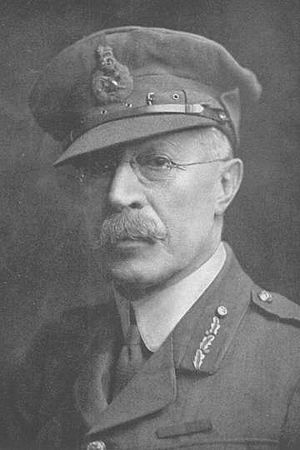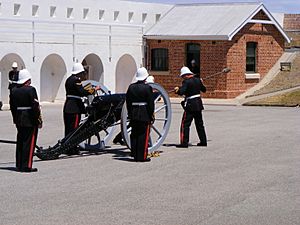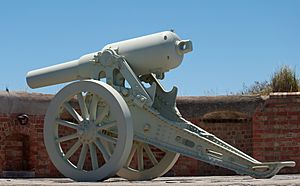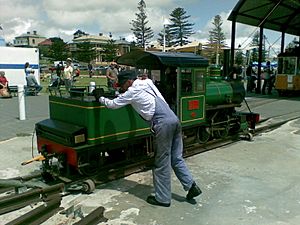Fort Glanville Conservation Park facts for kids
Quick facts for kids Fort Glanville Conservation ParkSouth Australia |
|
|---|---|
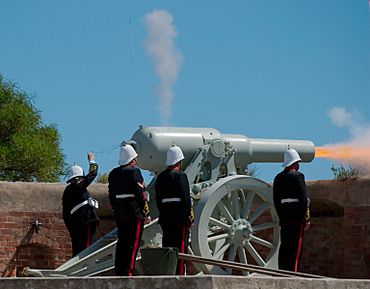
A firing demonstration with one of the fort's RML 64 pounder 64 cwt guns
|
|
| Nearest town or city | Semaphore Park, South Australia |
| Established | 1 January 1951 |
| Area | 5 ha (12 acres) |
| Visitation | 7,000 (in 1988) |
| Managing authorities | Department for Environment and Water |
| Website | Fort Glanville Conservation Park |
Fort Glanville Conservation Park is a special place in South Australia. It's located in Semaphore Park, a suburb by the sea in Adelaide. This park has a real 19th-century fort that still works! It's also listed on the South Australian Heritage Register.
This fort was built because people worried about defending South Australia. It was the very first fort built by the colonists in the state. Many people think it's one of the best-preserved forts in Australia. Fort Glanville was designed by two important people in early Australian defence: Governor Major General Sir William Jervois and Lieutenant Colonel Peter Scratchley. Its main job was to protect Semaphore's harbour and ships going into the Port River from enemy attacks by sea.
Building the fort started in 1878. It officially opened in October 1880 and was finished by 1882. Over time, another fort called Fort Largs became more important. By the end of the 1800s, Fort Glanville wasn't used much for defence. It was briefly used during World War I and World War II, but not for its original purpose. For most of the 1900s, the area was used for different things, like a caravan park and a boy scout camp.
In 1951, the state government took over. The fort became a conservation park. Now, the Department for Environment and Water (DEW) looks after it. They make sure its history is preserved and shared. The fort and its surroundings take up the northern part of the 5-hectare (12-acre) park. The southern part is still a caravan park. The fort is shaped like a half-moon and had powerful, modern weapons for its time. It has two large 10-inch guns and two 64-pounder guns. These guns are quite rare. The fort still has its original 19th-century cannons, and three of them can even be fired today!
The Fort Glanville Historical Association helps run the park. They have open days where they show how the fort used to work. This includes military drills and firing the old weapons. Many volunteers and grants have helped keep the fort looking almost exactly as it did originally. It's known as the most complete 19th-century fort in Australia. It's also one of the few in the world that remains in such original condition. There's even a fun Semaphore and Fort Glanville Tourist Railway that connects the fort to Semaphore jetty. It's a small steam train run by volunteers from the National Railway Museum.
Contents
Why Fort Glanville Was Built
In the early days of South Australia, people thought the British Empire would protect them. But tensions grew, especially with the Russian Empire in the 1850s. This made the colonists worry about their own safety. They realized they might need to defend themselves.
Many reports suggested building forts to protect the coast. Semaphore was chosen as a key location. This was because enemy ships were expected to attack from there. They would shell the port and land troops. In 1864, there was a scare about the Russian fleet attacking. This made the government finally decide to build a fort at Semaphore.
However, the first plans were too expensive and were stopped. South Australia's defence then relied on volunteer soldiers and a few cannons. In 1876, the government asked for advice from Major General Sir William Jervois. He was an expert in building coastal forts. He came to Australia with Lieutenant Colonel Scratchley.
Their 1877 report suggested building three forts: at Largs Bay, Semaphore, and Glenelg. These forts would be connected by a military road. They also needed naval support and mobile troops. Jervois believed South Australia would most likely face an attack from one or two ships. This idea guided the final design of the fort.
At this time, Semaphore was very important for South Australia. It was the main entry point for passengers and mail. It had a jetty, a signal station, and a time ball tower. Port Adelaide was the main port, with many ships visiting each year. This made protecting Semaphore and the Port River crucial.
Building the Fort
Scratchley looked at the possible fort locations in South Australia. He and Jervois were responsible for the final design and where the fort would be built. The first fort was meant to protect both the entrance to Port Adelaide and the ships anchored at Semaphore. It was built on sandhills near Glanville Hall. This spot was chosen to best guard ships sailing to the Port River and the Outer Harbour. It was seen as a defence against foreign threats, especially from Russia.
Scratchley offered to design the fort, and his offer was accepted in January 1878. He designed both Fort Glanville and Fort Largs. The plans were drawn by Alexander Bain Moncrieff. Construction began in 1878. The fort was finished by 1882, but it was ready to be used by 1880.
Some changes were made during construction. These included adding a wall at the back for extra security. By January 1880, two guns were in place. The fort officially opened on October 2, 1880, with a big ceremony. During the ceremony, they fired sixteen shots at a target far offshore. One of the large 10-inch guns had a problem. The fort cost about £36,000 (which would be millions today). When it was built, it was considered very advanced and "state of the art."
The fort was first called the Semaphore Battery, then South Battery. It was finally named Fort Glanville at the opening ceremony. The name came from nearby Glanville Hall, which belonged to John Hart, a former Premier of South Australia.
People Who Served at the Fort
After it opened, volunteer soldiers from the South Australian Volunteer Artillery manned the fort. They only worked on weekends. This changed in 1882 when South Australia created its first permanent military force. Fort Glanville became the main base for this small army.
Some soldiers were also stationed at nearby Fort Largs. By 1889, the permanent force had grown to 45 soldiers and one officer. This group was called the Permanent Artillery. They trained other soldiers who were sent to man forts in Western Australia. Some of these gunners fought in the Second Boer War.
The fort's soldiers were called out in 1890 to help police during a worker's strike in Port Adelaide. No shots were fired, and there was no fighting. After 1901, Australia's defence became a federal responsibility. The Permanent Artillery became part of the Royal Australian Artillery.
During World War I, the fort was still manned. Military records show it had soldiers until at least mid-1918. However, it's not clear if the guns were still in good working order by then.
Two important people served at the fort:
- Battery Sergeant Major Charles Moritz: He was the first soldier to join the Permanent Artillery.
- Joseph Maria Gordon: He was the fort's first commander. He later became the military commandant for South Australia. He retired in 1914 as the Chief of the General Staff for the Australian Military Forces.
Fort Structure and Design
The fort is designed like a half-moon, or a "lunette." Its main job was to protect Port Adelaide and Semaphore, not just itself. It was meant to be supported by other soldiers and cannons on land. The fort still looks much like it did originally. However, some parts like the ditch and embankment have changed over time.
A road was built from Military Road to the back gates of the fort. Today, the Queen Elizabeth II walk follows much of this old road. This path connects the park's visitor centre to the fort gates. The area where soldiers used to gather for training is now partly a caravan park and car park. In the 19th century, this "muster ground" was used for training volunteer troops.
The back of the fort was protected by a wooden fence called a palisade. In 1881, a strong stone wall was added. Most of the wooden fence was rebuilt in the 1970s. You can still see some of the original wood in the fort's north.
Fortification Features
The main defence is a strong, half-moon shaped earth wall called a rampart. It's about 15-metre (49 ft) thick. It has concrete and brick inside to hold the earth fill. The rampart is covered with plants and is usually closed to visitors to protect it.
Around the fort, there was a gentle slope called a glacis. This helped hide the fort and gave extra protection. It was made from the surrounding sandhills. The inner side of the glacis was steep, forming a ditch about 12 ft (3.7 m) wide. Soldiers could fire rifles from a special room called a caponier into this ditch. The outer slope was designed to be covered by cannon fire from the fort's 64-pounder guns.
You enter the fort through double gates at the back. These gates have been rebuilt. Inside, between the back walls and the barracks, is the "manning parade." This was used for training and formal gatherings. Around the seaward side of the parade is the terreplein. This is a raised area where the big guns sit.
In 1882, sand hills behind and north of the fort were removed. This improved the fort's land defence. It also allowed the 64-pounder guns to cover the Semaphore jetty. This flat area was used for troop exercises. Other buildings like stables and stores were also built north of the fort, but they are no longer there.
Inside the Fort
Next to the big guns on the terreplein are small rooms called expense stores. These held ammunition ready for the nearby guns. Between the large 10-inch guns are two raised platforms for gun commanders. From here, they could watch where their cannon shells landed.
Underneath the 10-inch gun area is the magazine. This is where gunpowder and shells were stored. A special loading gallery above used a hoist system to bring ammunition up to the guns.
The caponier, or rifle gallery, sticks out into the ditch from the fort's north-west corner. It's connected to the fort by a tunnel that goes under the rampart. The tunnel has a bend for protection against explosions. The caponier has small openings for rifles, allowing soldiers to fire into the ditch.
Fort Buildings
The barracks building has two levels. It has rifle firing holes on all sides. The first floor had rooms for officers and a large room for the troops. The barracks room could hold about 20 men. Today, it's set up to show how it looked in the past.
The basement of the barracks had the gunner's mess, a canteen, and a pantry. The canteen sold everyday items and snacks to the soldiers. Profits helped buy sports equipment for them. In 1887, an explosion in one of the basement rooms caused injuries and damage.
A laboratory is built into the fort's southern rear wall. This room was used to prepare gunpowder charges. A guardhouse was built in 1885 at the southern end of the manning parade. It had a guard's room and separate cells. Today, it's used by the drill squad during demonstrations.
Fort Weapons
The fort's main weapons were two large rifled muzzle-loading (RML) 10-inch 20-ton guns. These were made in 1879. They could fire 400-pound (181 kg) projectiles up to 6,500 yards (5,900 m). They were meant to fight against smaller enemy warships. These guns were loaded either by hand or with a mechanical system. The mechanical system didn't work well, so they were mostly loaded by hand. It took about 14 men and 2 minutes to load one of these huge guns.
By 1902, these guns had fired 219 practice shots. The gun platforms were removed in 1937, but the heavy gun barrels were left because they were too hard to cut up. One gun platform was rebuilt in 1997 with money raised by volunteers.
64-Pounder Guns
The fort also had two RML 64 pounder 64 cwt guns. These were made in 1872. They weighed about 64 long hundredweight (3,300 kg) and had a 6.3-inch (160 mm) wide barrel. Their job was to protect the sides and approaches to the fort. These smaller guns used an 8 lb (4 kg) gunpowder charge to fire a 64 lb (29 kg) projectile up to 5,000 yards (4,600 m).
These two guns are thought to be the last of their kind in the world in this specific setup. By 1902, they had fired 1540 practice rounds. The guns were removed in 1909 and placed in a garden in North Adelaide. They were brought back to the fort in 1976 and put on restored carriages. They are the only two guns of this type left in Australia. One of these guns is regularly fired by the Fort Glanville Historical Association volunteers today.
Other Weapons and Displays
The fort also had other weapons for close defence, like 16-pounder field guns. Later, it received a 12-pounder RML field gun and a Nordenfelt gun. These were used for training.
Today, the fort has three 16-pounder RML field guns. One of them is complete and used for blank firings by the Historical Association. There's also a rare 2-pounder RML Whitworth mountain gun from 1867. It's one of only two known to exist.
The visitor centre has two 9-pounder brass smoothbore field guns from 1819. These were used for practice near the fort long ago. They are now on loan from the History Trust of South Australia for display. Outside the visitor centre, you can see a large 6-inch breech-loading Armstrong gun from 1884. It was donated to the park in 1984.
Fort Glanville's Importance Today
Work began on Fort Glanville's sister fort, Fort Largs, in 1882. It was built to similar plans. However, plans for a third fort at Glenelg were never completed. By 1888, Fort Largs became more important for defending Adelaide's coast. This was partly because Fort Largs got newer, more powerful guns. Also, the Port River was deepened, allowing larger ships to dock directly instead of anchoring offshore.
Fort Glanville's importance as a defence site quickly decreased. By 1901, it was only looked after by caretakers. In 1903, the Australian Federal Government took over defence. Fort Glanville no longer had a major defence role. However, it became very important as the first and best-preserved 19th-century fort in South Australia.
The Fort in the 20th Century
After 1901, the fort was mostly neglected. It was used for different things, but not always military. During World War I, ammunition was stored there, and it was even used as a detention barracks. During the Great Depression, parts of the fort were rented out for people to live in. In the 1930s, the magazine was used to store small arms ammunition. From 1931 until World War II, it was a camp for Sea Scouts and Boy Scouts.
In 1937, the Department of Defence decided that much of the fort's equipment was no longer needed. The mountings for the 10-inch guns were removed and sold for scrap. The heavy gun barrels were left because they were too difficult to remove. In 1938, the fort even housed 29 refugees from the Maldives for a week!
During World War II, the fort was again used for military purposes. In 1944, it was used to test anti-tank guns. Families also lived in the underground parts of the fort during the war.
After the war, the State Government took control of Fort Glanville in 1951. It became a caravan and camping park, managed by the State Tourist Department. The fort's barracks building was used as a manager's home.
A big step for the fort's future was in 1972. It was declared a Historic Relic. People were starting to realize how important this site was for the state's history. Control of the park moved to the National Parks and Wildlife Service (NPWS). The fort and its surroundings became Fort Glanville Conservation Park. Funds were provided for conservation work, and the caravan park boundary was moved. Even though the site had been neglected, there wasn't much permanent damage.
In the 1970s, much of the wooden fence (stockade) was rebuilt. The old 64-pounder guns were returned to the fort. On October 2, 1980, one of the 64-pounders was fired again to mark 100 years since the first firing. Soon after, the Fort Glanville Historical Association was formed. Fort Glanville opened to the public in 1981.
In 1986, Queen Elizabeth II visited the fort and the new visitor centre. The historical association showed her how the cannons were fired. The visitor centre officially opened a month later. The old road was named "Queen Elizabeth II Walk" in 1991 to remember her visit. Since then, a lot of restoration work has been done on the fort, including the barracks.
Fort Glanville Today
Fort Glanville Conservation Park is one of South Australia's most important historical places. It's a top spot in the state, and maybe even Australia, for showing what colonial-era forts were like. The fort is listed on the South Australian Heritage Register. It's important because of its connection to Jervois and Scratchley, who were key defence experts.
The fort was built to last, which has helped keep it in good condition. It's mostly intact and looks original. Along with Bluff Battery in Hobart, it's one of the best-preserved forts designed by Jervois and Scratchley in Australia. It's the only Australian colonial fort that still has all its original weapons. It's also the only one with a regular "living history" program. Its sister fort, Fort Largs, still exists but has been changed a lot to become the South Australia Police academy.
The conservation park is in Semaphore Park. It covers about 5 hectares (12 acres) and is managed by the DEW. The northern half has the fort, and the southern half has a caravan park. The Fort Glanville Historical Association and a special committee help manage the park. In 1988, about 7,000 people visited the fort each year. It's also used for events like citizenship ceremonies.
The Historical Association is a group of volunteers. They run the fort and visitor centre. They have public open days every month where they recreate the fort's history. This includes showing military drills and firing the fort's weapons. They also have displays about the fort's active period and sell souvenirs. Their goal is to have the fort fully open for visitors to learn about its history. The volunteers also take part in historical re-enactments outside the fort.
The Semaphore and Fort Glanville Tourist Railway connects the fort to Semaphore jetty. It's a small steam train run by volunteers from the National Railway Museum. The railway opened in December 1992. By 2002, it carried over 16,000 passengers each year, offering a fun ride for visitors.
Images for kids
-
A firing demonstration with one of the fort's RML 64 pounder 64 cwt guns



